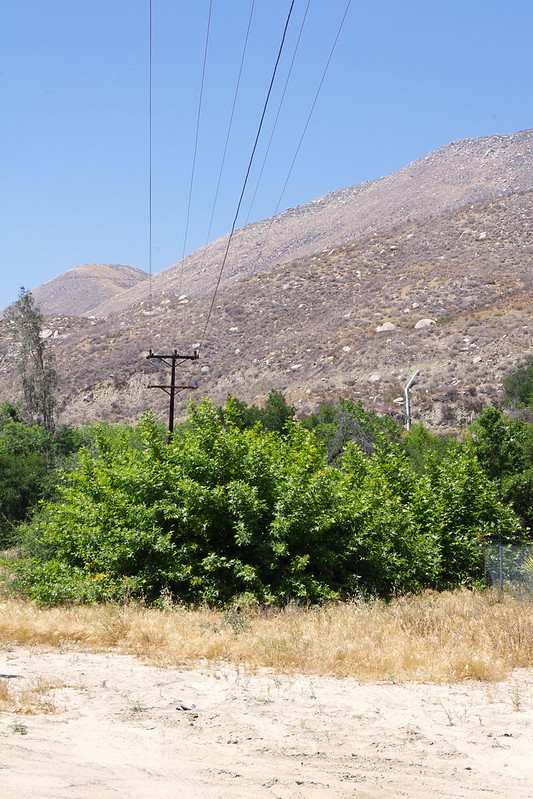Our original two story home (10 years ago) and neighbourhood was pleasant in the sense we all had backyards with gardens, nice neighbours and we specifcally had a backyard which offered a view of nothing but meadows and forest. Trust me, for a city Sweden that's rare. We also had an elaborate hiking trail system in those same woods behind our house, but unlike where I come from in Southern California, these woodlands are devoid of a lot of various critters and their sounds. Also missing are the scents and fragrances of the coastal sage scrub plant community I was use to. Cold doesn't necessarily facilitate the movement of fragrant scent compounds, even more so if they don't really exist here in the first place.
 |
| My photo from 2013 in the trail network behind Biskopsgården |
 |
| John C. Avise Side Blotched Lizard |
Redheaded House Finch
 |
| picture by Charles Parker |
This unfortunate mobile home fire tragedy took place at Starlight Mobile Home Park in El Cajon California. This was one of the properties I was assigned to maintain as head landscaper and this exact trailer space #128 and it's garden was territory of a Red Headed male House Finch who claimed his favourite perch on top of an old Peach tree behind this mobile home. This bird is another one of those birds I really miss as far as wild song birds. Every year in the Spring just after the blooming time of year this same House Finch would claim his perch at the top of that peach tree singing his heart out for hours. What I remember most is working there in the morning doing some sort of work with the lawn, it's irrigation system (which always needed maintaince) or doing something with the citrus trees. The Springs are idyllic there with crystal clear blue skies, perfect temperature (around 70 F or 21 C). Air was fresh and alive with all manner of fragrances of all sorts abundunt in the air (particularly citrus) and work was always pleasant and soothing with this bird's repetitive song playing over and over. To give you an idea of their song, here is a 14 minute video (audio really) of the male House Finch.
Western Meadowlarks
 |
| Kathy Munsel/Oregon Department of Fish and Wildlife |
This next bird sound comes from the Western Meadowlark which was once a common sound in San Diego county's interior valleys, but now a rarity there as well because of commercial housing development. Probably some of the last holdout habitats would be Ramona, Lakeside and maybe Otay Mesa. I'm sure there may be other pockets of grasslands scattered around, but it's the grasslands that are of most importance to this bird. But grasslands are generally on flat or rolling hills and those are perfect for development. The photo above would have been a common perch for such a bird on a Silver Sagebrush. Later when cattlemen came, the various fence posts would replace those shrubs. Shrubs would have been considered a curse to cattle operations in favour of grasses. So once removed, the fence post would have worked just fine. When I was growing up in the early 1960s, pockets of grasslands were everywhere with the largest being the San Diego River floodplain in the middle of Santee/Lakeside California. Santee still had many range cattle back then, but the Santee bedroom district building boom was in full steam ahead in late 60s thru 70s and gradually these habitats shrunk to almost nothing as have the meadowlarks. Listening to their songs makes me think of long warm summer days.
Fragrances of Coastal Sage Scrub
 |
| Image: Bert Wilson - Salvia 'Celestial Blue' Sage |
 |
| Image - My photo 2014 |
 |
| Image - My Photo 2014 |
My mother's place across from Pepper Drive School in El Cajon California. 'Canyon Sparkles' Manzanita, 'Pozo Blue' Sage, and Mexican Red Bird of Paradise Bush.
And Finally, Crickets & other Night SoundsFrankly any sounds at night is another rarity for me here in Sweden. It struck me as odd that there were no night sounds here when I first came, especially crickets. Like the lizards on the trail which one takes for granted because they are so common and you are use to their presence, but then suddenly you realize their absence when they are not around. The lack of cricket sounds was also immediately noticed by me. Imagine no sounds at all on summer evenings. Not even owls or frogs. Well, maybe Mosquitoes. Click on the Youtube audio below and imagine nighttime scenarios with no sounds. Funny how one can notice the absence of things.
To be fair to Sweden, they do have the 'Koltrast' (common Blackbird) song
One pretty sound that is common here in this part of Sweden that is pleasant when walking through a tall Boreal Forest (that's not an industrial forestry plantation) in the Springtime is listening to the 'Koltrast' which is just a larger common blackbird than what I'm use to seeing in SoCal. The males are the singers and their songs echo loudly within the forest, not like when there is more open urban environment. At least they don't have 'Silent Spring' yet. Here is another Youtube link to sights and sounds of both male and female Blackbirds or Koltrasts.
Song and calls of the Blackbird
Maybe later if I think of something more, I'll add it to the list 😉
















































